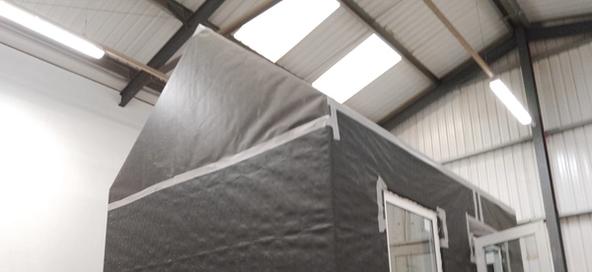Article
It Shouldn’t Happen to an Airtightness Tester!
Real tales from the measured performance front line. When people ask what I do for a living, I tell them I “help develop building performance products and also physically measure how buildings actually perform.” This is true, but it doesn’t cover the part where I end up in unheated warehouses, rooftop apartments, historic landmarks protected by security teams, and occasionally negotiating with strangers for electricity.
So for anyone who thinks building performance testing is simply “pop in, take a few readings, and head home,” allow me to share a few greatest hits…

Scenario 1: The warehouse that was a little too warm
We’d been booked to provide U-value measurements on a purpose-built prototype structure inside a warehouse. Beforehand, we’d asked the client to pre-heat the structure to ensure a stable temperature difference.
We arrived to find… industrial gas heaters. Big ones. Very powerful ones. Doing an excellent job….of heating the warehouse. The entire warehouse.
Meanwhile, the test structure itself sat politely inside… at roughly the same temperature as before.
Cue the gentlest conversation of my professional career:
“So… we are trying to measure heat leaving the structure… which is…difficult… if we are heating the outside instead of the inside.”
On the plus side, I’ve never been warmer in April.

Scenario 2: The day I accidentally looked like a security threat
Testing in historic buildings in central London can be surreal.These are the sorts of places where bags are scanned, passes are temporary and the security guards do not play.
Now imagine trying to walk in carrying several large cylindrical devices (hello, Pulse kits) that, to the untrained eye, look suspiciously like the exact type of item that the security team is there specifically to prevent entering the building. Scene from Trigger Point, anyone?!
There is no training module for this moment. Just your ability to smile politely and say: “They measure airtightness. Not… anything else.”
We got in. Eventually.

Scenario 3: Balmy Manchester, where heat loss tests become sauna sessions
“Heat loss measurement is winter work,” someone once said. That person has not been to Manchester in a warm April.
External temperature: 14°C. Internal temperature (unoccupied apartment with no running water): 35°C

At that point the job becomes less technical evaluation and more hydration endurance event.
We learned two things that day: always take more water than you think you need and that heat moves in mysterious ways, especially in high-rise glazing with full solar gain.
Scenario 4: The day we learned electricity is important, even in Wales!
Pre-heating requires heat. Airtightness testing requires electricity. Testing generally works better when these things exist.
We arrived on site in South Wales to discover no gas and no electricity.

However, and this is where the job gets truly unpredictable, a local photographer just happened to have a 230V, 2kW power bank available for hire.
Yes, really.
So our airtightness test was powered by… photography equipment.
Engineering is problem solving, sometimes quite literally.
In Conclusion…
People think building performance is about numbers. And yes, it is. But it is also about:
- Communication
- Creative improvisation
- Situational awareness
- Staying hydrated
- And occasionally borrowing power from a stranger with a very well-equipped camera bag
We measure buildings in the real world, and the real world is… character building.
Would I swap it? Not a chance. The stories are too good!


